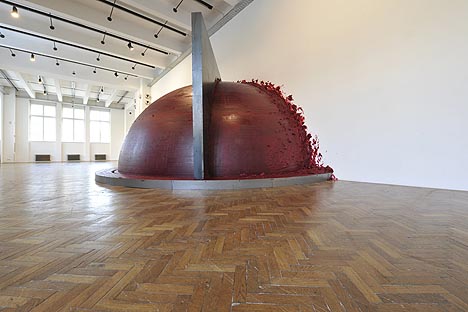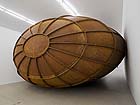
translated and summarized by: Liz Wollner-Grandville,
English summary January 19 - 25
MAK: Anish Kapoor – Shooting into the Corner
Much Ado About Too Little
If you think of Anish Kapoor as a sculptor, who “copes with space” you will be disappointed by his current Vienna exhibit. The subtitle “new space filling works at the MAK” contradicts the actual implementation: absolutely nothing fills the space.
Admittedly: Kapoor is Kapoor, and his works, which at the MAK exhibition are mainly made up of crimson wax-Vaseline-mixtures, are impressive: the red dome-shaped heap, whose surface is shaven by a metal piece slowly sliding over it (“Past, Present, Future”) as well as the semi-spherical hollowed corner (“Shadow Corner”), where basically the same thing is going on. The central and title-giving work “Shooting into the Corner” achieved dramatic effects (especially at the vernissage). The work shows a cannon shooting wax bullets into a corner, and expectations are such that, at the end of the exhibit, the bullet-heap will weigh approximately 20 tons.
Currently the whole thing looks rather pathetic and has little relation to the spectacular and loud firing of the cannon. For security reasons visitors are kept at a distance through a high barrier, which, however, also intensifies the staginess. If there weren’t so little to see, this would actually not be a bad thing. The other sculptures are also too small for the large rooms: “Shadow Corner” seems as if it were stuck to the front part of the room, which otherwise is completely empty. “Past, Present, Future” is also surrounded by too much vacant space - only the semi-spherical wax circle (“Push-Pull II”) comes into its own.
Involuntarily, all of this stands in ironical contrast to the pathos, with which one would like to mediate Kapoor’s work (there is talk about “change, caducity, and new beginning” and about “philosophy of the hidden”, of the “intellectual and transcendent”) and as well as to the enormous efforts, which have been made. But possibly the heap will grow to such an extent that one could then really talk of “space filling works”.
Nina Schedlmayer
MAK-Applied Arts/Contemporary Art
1010 Vienna, Stubenring 5, until 19.04.09
www.mak.at
Deutsche Guggenheim: Anish Kapoor – Memory
Egg-mazement
The first impression leaves you with something disconcertingly grotesque. Whatever it is that is piling up in front of us, it definitely does not belong here, seems to have made its way by mistake to the German Guggenheim: a rusty red colossus, which seems like it was stranded, hopelessly stuck between the walls, the ceiling, and the floor of the now depressingly narrow White Cube. It seems as if an - for the time being - unknown object had an accident: a submarine? An airship? Maybe even an UFO shaped like a humungous egg?
However, this mystery won’t be solved – on the contrary, there are more to come. Turner Prize winner Anish Kapoor installed “Memory” in such a way, that the observer has no chance to see the object from all sides, as it is impossible to walk around it. The two perspectives, which are allocated to the onlooker - one from the main entrance and the other from an emergency exit – show two distinctly different halves, each offering individual conclusions with respect to the form and size of the entire object, whereby not only the “what” but also the “why” of the object becomes questionable. This asymmetry is, however, only part of a fundamental ambivalence, by which this work is so clearly distinguished and with which it probably plays intentionally, circling around the poles of statics and dynamics as well as heaviness and lightness: the sculpture, which – a novelty in Kapoor’s choice of material – was created with Corten-steel, appears surprisingly weightless despite its 24 tons, for which the Guggenheim floor had to be especially fortified. On account of its minimal contact with the floor, it does not convey the feeling of anything heavy or oppressive, and – because of its balloon-like appearance it conveys something light, as if it were levitating. And this in turn addresses the next dichotomy: namely its suppressed movement, which - in contrast to a balloon, whose intrinsic factor is motion –forces the object to stay in one place: the balloon is simply stuck.
And there are more unfathomable ambiguities constituted by this sculpture. Kapoor decided to make the inside of the object accessible: via a breakthrough in the wall of the museum shop on can enter the object and see – nothing. To be exact: a black nothing. With reference to art history one would say: we see a black plane, whose resemblance to Malevich’s Black Square is no coincidence. Only after entering deeper into the object our eyes gradually perceive, or at least surmise, its dimension and actual size. The entirety of the inside, on account of the cleverly thought out wall opening, is difficult to perceive. The inside of the sculpture is contrived in the same immeasurability as the outside - its size cannot be objectively determined. Therefore, the onlooker therefore has to judge the sculpture on his own accord, and has to assemble the views, which he kept in his memory – after all; the object was not titles “Memory” to no purpose - into a uniform perception. Whereby “Memory” proves to be an “open art work”, which needs this type of a viewer for its completion - a factor, which finds a splendid symbol with the open window in the wall. The window, oscillating between two- and three dimensionality and which could also avow for Alberti’s finestra aperta; and the illusionism could also refer to Plato’s allegory of the cave, whose fundamental arrangement – the view into a cave, light coming in from the back, shadows – finds itself repeated here.
In short: “Memory” presents a huge aesthetic, phenomenological, and epistemological challenge. And whatever that is able to accomplish must also be great art.
Peter Kunitzky
Deutsche Guggenheim Berlin
10117 Berlin, Unter den Linden 13 – 15, until 01.02.09
www.deutsche-guggenheim-berlin.de
MUMOK: Peter Kogler
The topological monolith and its residents
This retrospective clearly demonstrates the evolution of Peter Kogler’s work analogous to the development of technical developments: in 1981 he drew a series of rats as white shadows with a shaded china ink background onto an empty carton picture frame; in 2008, a digital project lets the same rats run across the black monolith of the MUMOK.
Peter Kogler’s early works are dominated by charcoal drawings and sculptures made of carton. Anthropomorphic sculptures are assembled out of small carton cubes or triangles. A human being is merged into constructed space - as a red brick wall with black shadow beings integrated into the roof. The strung-out five-cornered gable house already implies the one-dimensional direction of movement, inspired by Fritz Lang’s and Sergey Eisenstein’s expressionist film architecture - “Dr. Caligari’s Cabinet” (Robert Wiene) and “The Last Laugh” (F.W. Murnau).
With the oftentimes serial and pattern-like character of these early works, Kogler seems to have waited for the switch from charcoal to silicon. It was around the mid 80s that the new digital media enabled him to create the computer-generated patterns with their easily recognizable themes: pipes, gyri, and ants, morphological structures cover entire exhibition halls. Soon Kogler’s original source of inspiration transforms itself to its own involvement within contemporary architecture. He boldly creates architecture-embracing film on public buildings. They transform the building into an excessive “scream”, the “dernier cri”, from Nietzsche’s “Last Man”, which nobody can revoke from.
An ant once walked across the newspaper… Peter Kogler made it the icon of consciousness of one-dimensional progression in an entwined space, which is always flat; as flat as the Ricci-term in Einstein’s understanding of space, which led to search for the higher dimensionality in three-D.
Kogler’s first computer animation “Without a title” (1993) is a tracking shot through a hole. The net-like structure of wads of smoke, his newest computer generated wallpaper, seems consecutively logical, by making the mathematical structures of higher dimensional inner parts of the Calabi-Yau manifold of mathematicians – this complex entwined hole accessible. Kogler’s virtual interior design finds its peak in the omnidirectional projected computer animation of moving grid structures, which condense, become soft, liquefy and finally dissolve into streaks – supported by Franz Pomassl’s
dramatically accentuated music.
Like no other artist, Kogler presents the view of the world as Peter Sloterdijk describes the “inner and outer world of foam”. Kogler represents the Pop Art of topology. The white lab rats in the maze are now ants that don’t know top from bottom – just like topological architecture brings forth disoriented buildings, to which one no longer finds the entrance.
One may dislike Peter Kogler’s work, because one dislikes this kind of world, nevertheless he visualizes one-dimensionality with a monumentality for which one can be thankful.
Renate Quehenberger
MUMOK Museum moderner Kunst
1070 Vienna, Museumsquartier, until 01.02.09
www.mumok.at
Kunsthalle Krems: Duane Hanson – Sculptures of the American Dream
Hell inside of me
If Duane Hanson (1925 – 1996) would have lived to see this annus horribilis, which not only led the US economy into a recession, he would – as an artist - have been delighted with the amount of people, who were suddenly left with nothing: these homeless former house owners, headless investment bankers, unemployed automobile producers, etc. The economic catastrophe would have bestowed him with an infinite number of new loser-types; and Hanson’s portraits always aimed at those, whose dream of the American way of life – similar to a small private speculative bubble – had irrevocably burst.
This retrospective with its 30 works lets us enter into a world, which could not be more dismal. An under-world, a hell of authenticity, inhabited by the mediocre representatives of the American middle- and working class, who are lonely and isolated, introverted and paralyzed in their own existence, and an after-world on account of a condition we would describe as “too-late”. Hanson’s work depicts the quiet survivors of their personal catastrophe, prototypes of the American loser who fell by the wayside during their pursuit of happiness. A contest pursued by many people, because they carelessly believe in the unattainable promises made by the world of consumerism.
Hanson, to avoid the danger that his creations could by shrugged off as mislead consumer-idiots, bestowed them with an inner-eye, a soul. An observant viewer, who is not deceived by their first satirical semblance, will easily notice that all of the figures are other-worldly and withhold any communication by directing their look towards the inside. This effect, which shapes individuals out of the potentially stereotype figures, deserving our empathy and compassion. But it is also an effect, which wears off over time, especially if we are faced with an army of lost souls, who all want our sympathy at once. Towards the end of the exhibit one feels like wandering through a Richard Yates’ novel; Yates, who also attempted to describe the great American disillusionment, but luckily did not forget to impregnate the scene with distraught humour, which makes everything so much more bearable; or one felt like being in an anomaly of Madame Tussaud’s – where not the winners, but the losers were haunting you.
Peter Kunitzky
Kunsthalle Krems
3500 Krems, Franz-Zeller-Platz 3, until 01.03.09
www.kunsthalle.at
Mehr Texte von translated and summarized by: Liz Wollner-Grandville


 Teilen
Teilen




